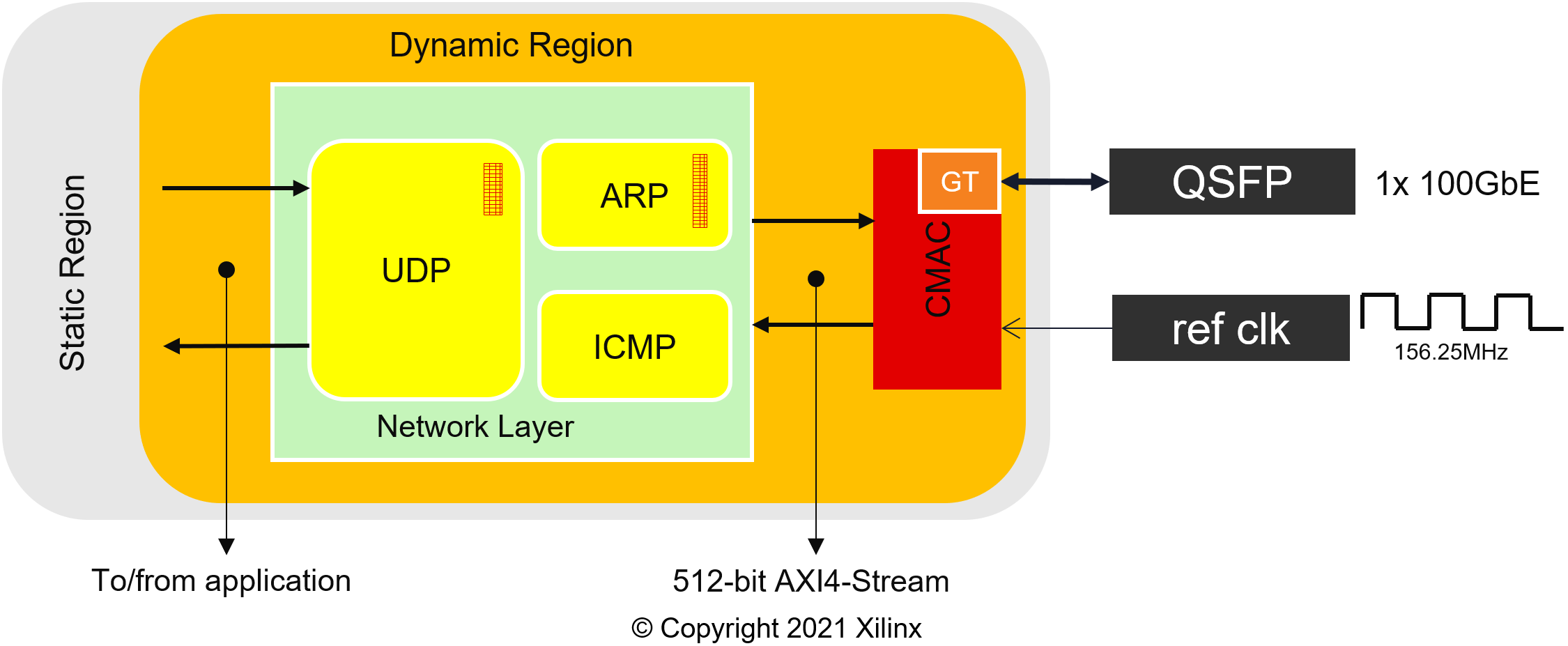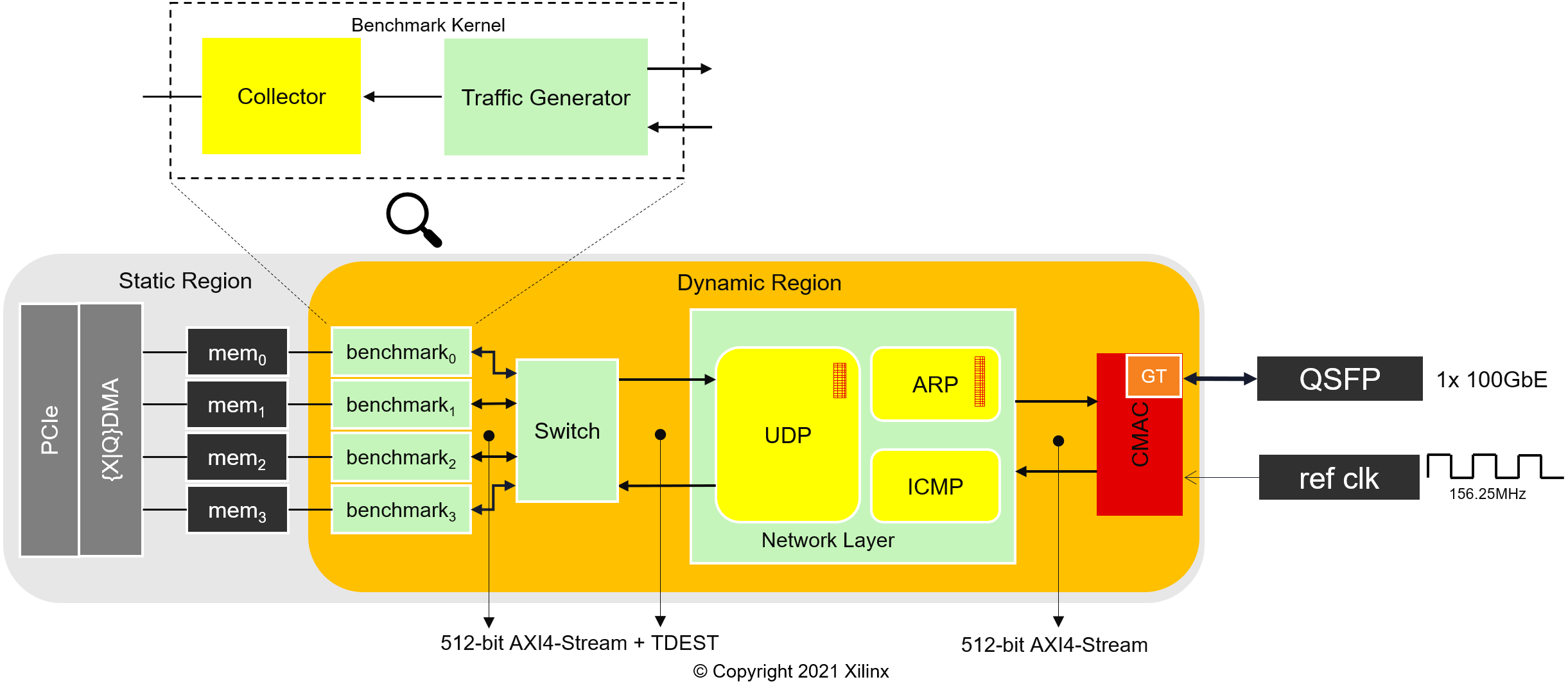This repository contains IP that you can use to add 100 Gbit/s networking to your Vitis designs. UDP is used as the transport protocol, and allows you to connect your Alveo card to other network equipment or Alveo cards.
Design examples are provided that show you how to integrate this IP into your Vitis design. One example shows you how to benchmark the network connection and the another shows you how to move data from the host to the network and vice versa.
The provided IP can be used with any Alveo shell that exposes the QSFP28 Gigabit Transceiver (GT) pins to the dynamic region, see supported platforms below. To find out more check out Designing a Transceiver-based Application with Vitis.
This repository provides:
- Source code for the common network infrastructure with UDP support
- Scripts to compile and link the kernels
- Out-of-the-box applications that uses UDP as transport protocol (
basicandbenchmark) pynqhost code and helper functions- DASK integration for multiple FPGAs configuration and task scheduling
Get everything you need by cloning the repository, recursively.
git clone https://github.com/Xilinx/xup_vitis_network_example.git --recursiveThis section provides a brief overview of the common infrastructure needed for the examples to work. The examples rely on the same underlying infrastructure, which is cmac and network_layer kernels.
NOTE: the reference clock frequency can change depending on the Alveo card.
The cmac_kernel contains an UltraScale+ Integrated 100G Ethernet Subsystem. This kernel is configured according to the INTERFACE and DEVICE arguments passed to make. It exposes two 512-bit AXI4-Stream interfaces (S_AXIS and M_AXIS) to the user logic, which run at the same frequency as the kernel, internally it has CDC (clock domain crossing) logic to convert from kernel clock to the 100G Ethernet Subsystem clock. It also provides and AXI4-Lite interface to check cmac statistics.
The network layer kernel is a collection of HLS modules to provide basic network functionality. It exposes two 512-bit (with 16-bit TDEST) AXI4-Stream to the application, S_AXIS_sk2nl and M_AXIS_nl2sk.
The ARP table is readable from the host side, and the UDP table is configurable from the host as well. Helper functions to read and configure the tables are available in the class NetworkLayer Notebooks/vnx_utils.py.
The application communicates with the UDP module using S_AXIS_sk2nl and M_AXIS_nl2sk AXI4-Stream interfaces with the following structure:
struct my_axis_udp {
ap_uint<512> data;
ap_uint< 64> keep;
ap_uint< 16> dest;
ap_uint< 1> last;
}In the Rx path, the network layer provides additional metadata in the user signal. To find out more about this kernel check out NetLayers/README.md
The following figure depicts the different kernels and their interconnection in the Vitis project for the basic example.
NOTE: the reference clock frequency can change depending on the Alveo card.
cmac and network layer kernels are explained in the section above. In this example the application is split into two kernels, memory mapped to stream (mm2s) and stream to memory mapped (s2mm).
-
mm2s: pulls data from global memory and converts it to a 512-bit stream. It chunks the data into 1408-Byte packets, meaning that last is asserted. It also asserts last when there is no more data to send. The dest is set according to the argument with the same name.
-
s2mm: gets payload from the UDP module and push the payload to global memory. dest and last are ignored in this module.
The current limitation of this application is that the size of the data must be multiple of 64-Byte to work properly.
Check out vnx-basic notebook to see how to run this example using pynq.
The following figure depicts the benchmark example design, which contains four benchmark kernels. Each benchmark kernel has two modules, traffic generator and collector.
NOTE: the reference clock frequency can change depending on the Alveo card.
Find out more information about the benchmark kernel in Benchmark_kernel/README.md
The following notebooks demonstrate how to use the benchmark example design to measure throughput and latency either point to point or with a switch connection between two Alveo cards.
In order to implement this design you need Vitis 2021.1 or newer and associated XRT. Older version of the tools are discouraged and will not work.
| Vitis | XRT | pynq |
|---|---|---|
| 2021.1 | 2.11.634 | 2.7 |
To install pynq and JupyterLab follow the steps here.
NOTE: for XRT version 2.12 or newer please apply this patch in the pynq package PYNQ#1343. NOTE: for Vitis version 2021.2 or older, make sure the Y2K22 patch is applied.
| Alveo | Development Target Platform(s) | Notes |
|---|---|---|
| U50 | xilinx_u50_gen3x16_xdma_201920_3 | |
| U55C | xilinx_u55c_gen3x16_xdma_2_202110_1 | |
| U200 | xilinx_u200_gen3x16_xdma_1_202110_1 | |
| U250 | xilinx_u250_gen3x16_xdma_3_1_202020_1 | DFX two-stage platform |
| U280 | xilinx_u280_xdma_201920_3 |
In order to generate this design you will need a valid UltraScale+ Integrated 100G Ethernet Subsystem license set up in Vivado.
To implement any of the examples run:
make all DEVICE=<full platform path> INTERFACE=<interface number> DESIGN=<design name>DEVICEAlveo development target platform, see supported platformsINTERFACEdefines which physical interface is going to be use. 0, 1 or 3 are supported. WhenINTERFACE=3the design will be replicated for each interface. Note that Alveo U50 only has one interface available (INTERFACE=0)DESIGNonly support the following stringsbasicandbenchmark. If you use something different, an error will be reported- The basic configuration file is pulled from config_files folder and complete with
userPostSysLinkOverlayTclparameter before callingv++. - Ethernet/post_sys_link.tcl is automatically called from
v++after system link. It is used to connect the GT capable pins to the cmac kernel(s) - The
XCLBINwill be generated in the folder <DESIGN>.intf_<INTERFACE>.<(short)DEVICE>
├── Basic_kernels
│ └── src
├── Benchmark_kernel
│ └── src
├── config_files
├── Ethernet
│ └── cmac
├── img
├── NetLayers
│ ├── 100G-fpga-network-stack-core
│ └── src
└── Notebooks
- Basic_kernels: this folder contains the code for the basic application (mm2s and s2mm)
- Benchmark_kernel: this folder contains the benchmark application, which includes the collector, traffic generator and switch kernels
- config_files: this folder contains the different configuration files for the different examples and flavors
- Ethernet: this folder contains the logic to generate the cmac kernel for the different Alveo cards and interfaces
- img: this folder contains images
- NetLayers: this folder contains the logic to generate the network_layer kernel, using the submodule
100G-fpga-network-stack-core - Notebooks: this folder contains companion Jupyter notebooks to show how to run the different examples
Open an issue with as much details as you can. Please, use the issue template and fill in the appropriate fields.
This design does NOT support FEC neither auto-negotiation. Therefore, make sure that your network equipment has these capabilities disabled. Please, refer to your network equipment manual to accomplish this.
Python host code in combination with the pynq package and JupyterLab as well as DASK provide the right environment to demonstrate the capabilities of this project. A minimalist C/C++ driver contributed from the community is available in the host_xrt branch. We welcome any contribution to enhance the driver. You can also find (partial) support for some of the kernels here.
Please, follow the contributing guidelines
VXx IS NOT a Network Interface Card (NIC). VNx main goal is to provide networking offload to Vitis kernels, so these kernels can communicate from one Alveo card to another without spending CPU cycles and minimum communication latency.
If you are interested in a NIC design, please check out OpenNIC Platform
VNx was originally developed within Xilinx University Program to support compute application that need to scale out. It has now been open sourced by Xilinx as a community resource. VNx is not a Xilinx product and so does not have formal Xilinx support in place, GitHub issues is the best place to request support.
Vitis Network Example (VNx) License BSD 3-Clause License
Ethernet/cmac License: BSD 3-Clause License
NetLayers/100G-fpga-network-stack-core License: BSD 3-Clause License
Copyright© 2022 Xilinx


